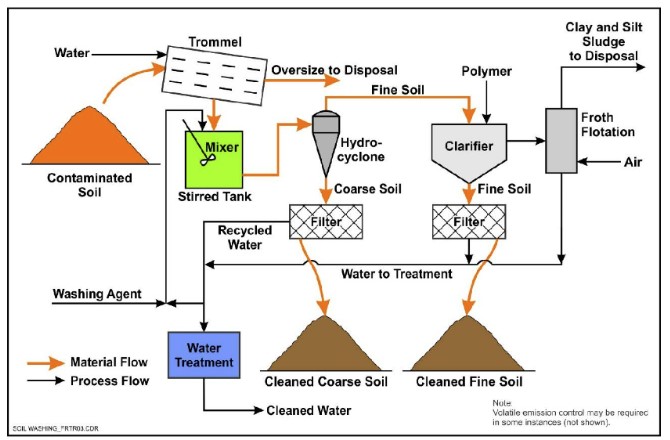Ingenious PFAS Therapy Solutions for Safer Water
The raising prevalence of PFAS contamination in water materials necessitates an important examination of ingenious treatment remedies. In addition, emerging bioremediation strategies supply a more lasting technique to dealing with PFAS challenges. pfas management.
Summary of PFAS Contamination
PFAS contamination has actually emerged as a substantial environmental and public wellness issue. Per- and polyfluoroalkyl substances (PFAS) are a team of synthetic chemicals recognized for their determination in the environment and body, leading them to be commonly referred to as "permanently chemicals." These substances have actually been extensively made use of in numerous markets, consisting of firefighting foams, water-repellent materials, and food packaging, mostly as a result of their water- and grease-resistant properties.
The prevalent use PFAS has resulted in their detection in dirt, water supplies, and also in the blood of people and pets. Research studies have linked PFAS direct exposure to countless health and wellness issues, consisting of developmental effects in infants, immune system disorder, and different kinds of cancer. Additionally, the ecological determination of these substances complicates their destruction and elimination, increasing concerns regarding long-lasting ecological effects.
Regulative bodies are significantly applying strict guidelines to monitor and decrease PFAS levels in alcohol consumption water and various other ecological tools. As recognition of PFAS contamination grows, it has actually ended up being imperative for neighborhoods and sectors to look for effective treatment remedies to minimize exposure and guard public health and wellness.
Advanced Purification Technologies
As the necessity to attend to PFAS contamination heightens, progressed filtration technologies have actually become an essential part in the remediation efforts focused on getting rid of these persistent chemicals from water resources. These innovations take advantage of innovative devices to effectively target and catch PFAS substances, which are notoriously resistant to traditional treatment methods.
Among the most encouraging approaches is the usage of granular turned on carbon (GAC), which adsorbs PFAS molecules due to its high area and porous structure. This technique has actually been widely executed in both local and industrial settings, demonstrating considerable decreases in PFAS focus. In addition, ion exchange resins have gotten grip, specifically created to selectively bind PFAS ions from water, thus promoting their elimination.
Membrane layer purification innovations, such as reverse osmosis and nanofiltration, additionally show efficacy in PFAS elimination by physically separating pollutants from water - pfas management. These systems can achieve high degrees of purity, making them suitable for alcohol consumption water applications
Chemical Treatment Innovations
Various chemical treatment advancements are being explored to efficiently address PFAS contamination in water supplies. One encouraging strategy entails the usage of advanced oxidation processes (AOPs), which utilize effective oxidants such as ozone, hydrogen peroxide, or chlorine dioxide incorporated with UV light to damage down PFAS compounds into much less harmful materials. This approach has actually demonstrated efficacy in laboratory settings, revealing potential for scalability in real-world applications.
One more ingenious method is the development of ion-exchange resins specifically created to target PFAS. These materials can selectively adsorb PFAS compounds from water, enabling for their elimination during therapy procedures. Recent developments have actually improved the performance and capability of these materials, making them a beneficial option for water therapy centers.
Additionally, scientists are examining using chemical agents like persulfate and ferrous ions to improve the deterioration of PFAS in infected water. These representatives can cause chemical responses that promote the failure of consistent PFAS substances.
Arising Bioremediation Techniques
Current advancements in chemical therapy technologies have actually led the way for checking out bioremediation techniques as a practical option get more for resolving PFAS contamination. Bioremediation uses the all-natural metabolic procedures of microorganisms to deteriorate or change pollutants, making it an attractive technique for dealing with consistent impurities like PFAS.
Emerging strategies in bioremediation include the usage of genetically engineered microbes that can especially target and break down PFAS compounds. These microbial pressures are being created for their improved degradation capacities, boosting the effectiveness of the removal process. In addition, scientists are examining the capacity of plant-assisted bioremediation, where certain plant species may uptake and sequester PFAS from polluted soil and water.
One more promising strategy is the application of bioaugmentation, which involves presenting advantageous microbes into polluted environments to boost the deterioration of PFAS. This approach can assist in quicker remediation timelines and improve total effectiveness.

Governing Frameworks and Requirements
A comprehensive regulatory structure is important for efficiently taking care of PFAS contamination and guaranteeing public health and wellness defense. The raising acknowledgment of per- and polyfluoroalkyl compounds (PFAS) as environmental contaminants has motivated various federal and state firms to establish requirements that govern their presence in water products. The United State Epa (EPA) has established wellness advisories and is pursuing establishing enforceable limitations for PFAS in drinking water.
State-level guidelines differ dramatically, with some states adopting more stringent standards than those suggested by the EPA. These policies often include optimum pollutant levels (MCLs) for specific PFAS substances, monitoring requirements, and reporting commitments for water energies. In addition, emerging frameworks concentrate on other the removal of infected sites, highlighting the demand for effective treatment innovations.

Final Thought
To conclude, the advancement and application of innovative PFAS therapy services are important for attending to the pervasive concern of water contamination. Advanced purification modern technologies, chemical therapies, and arising bioremediation techniques collectively provide a complex approach to efficiently minimize and break down PFAS levels. As regulative structures remain to evolve, integrating these modern technologies will be necessary to guard public health and recover the integrity of contaminated water sources, eventually contributing to a cleaner and safer atmosphere.